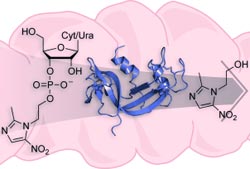Timely Delivery

<br>
Many drug candidates fail because of low solubility or poor pharmacokinetic behavior. Ron Raines and colleagues at the University of Wisconsin–Madison (USA) have devised a new prodrug strategy to overcome these limitations.
Their approach takes advantage of the capacity of an enzyme prevalent in human serum–pancreatic-type ribonuclease—to catalyze the cleavage of a drug conjugated to a ribonucleoside 3'-phosphate; the results of their work are reported in ChemMedChem.
They demonstrated efficacy by using metronidazole, a sparingly soluble antibiotic that is often administered orally. In the absence of ribonuclease, metronidazole conjugates are stable and inactive. Physiological levels of enzyme render the conjugate toxic to Bacteroides fragilis, a common penicillin-resistant bacillus that is responsible for anaerobic infections.
Alterations to the ribonucleoside enable modulation of key attributes, such as the rate of drug delivery. This study paves the way for further research into the activation and timed release of drugs of varying aqueous solubility.
About the Author
Dr. Ronald T. Raines is the Henry Lardy Professor of Biochemistry and a Professor of Chemistry at the University of Wisconsin–Madison. His research is focused on the chemistry and biology of proteins.
Author: Ronald T. Raines, University of Wisconsin–Madison (USA), http://www.chem.wisc.edu/users/raines
Title: Ribonucleoside 3'-Phosphates as Pro-Moieties for an Orally Administered Drug
ChemMedChem 2012, 7, No. 8, Permalink to the article: http://dx.doi.org/10.1002/cmdc.201200243
Media Contact
All latest news from the category: Life Sciences and Chemistry
Articles and reports from the Life Sciences and chemistry area deal with applied and basic research into modern biology, chemistry and human medicine.
Valuable information can be found on a range of life sciences fields including bacteriology, biochemistry, bionics, bioinformatics, biophysics, biotechnology, genetics, geobotany, human biology, marine biology, microbiology, molecular biology, cellular biology, zoology, bioinorganic chemistry, microchemistry and environmental chemistry.
Newest articles

Silicon Carbide Innovation Alliance to drive industrial-scale semiconductor work
Known for its ability to withstand extreme environments and high voltages, silicon carbide (SiC) is a semiconducting material made up of silicon and carbon atoms arranged into crystals that is…

New SPECT/CT technique shows impressive biomarker identification
…offers increased access for prostate cancer patients. A novel SPECT/CT acquisition method can accurately detect radiopharmaceutical biodistribution in a convenient manner for prostate cancer patients, opening the door for more…

How 3D printers can give robots a soft touch
Soft skin coverings and touch sensors have emerged as a promising feature for robots that are both safer and more intuitive for human interaction, but they are expensive and difficult…





















